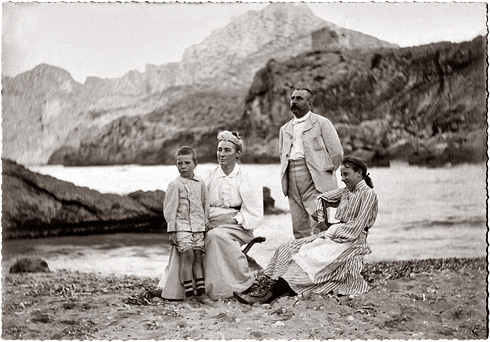A forward looking school
The foot of the Serra de Tramuntana, one Thursday in April: a group of schoolchildren of both sexes are on an outing with their teachers. They walk through the dry countryside and stop next to some European fan palms while the teacher tells them about this native plant and how it is used locally, by people like their parents, to make brooms, hats, baskets or chairs with the plant's leaves. The outing's objective is for students to observe everyday objects in their natural state and to broaden their knowledge: a kind of 'open-air' school, like that advocated by modern pedagogues.
So far there is nothing unusual about all this. However, if you examine the scene and its protagonists more closely, you will be surprised to see their late 19th century clothes. Many years must pass before the Spanish Second Republic breaths new life into the education system and boys and girls can attend classes together. What is more, some of the children are so poorly dressed that it is unthinkable for someone of their station to have access to education at this point in time. And what are they doing outside school? How come the girls are not sewing? And none of the children is kneeling or wearing donkey's ears. More importantly, the children did not begin the day praying but singing...
Near Pollença, one Thursday in April 1885. Pupils from Escola de Colonya (the first pedagogical initiative by the Institución Libre de Enseñanaza or ILE outside Madrid and a pioneering co-educational Spanish school) have gone on an outing, as they do every Thursday. This is a special occasion, because with them is Manuel Cossió, a Krausist pedagogue and good friend of Guillem Cifre de Colonya, founder of the Pollença school. After visiting the newly inaugurated school, built according to avant-garde educational criteria, a visibly impressed Cossió exclaims: "This is Europe!"
Europe was a reference for the ILE's promoters and they often travelled there to get to know other innovative educational initiatives. Guillem Cifre de Colonya was one of them. On one of his stays in Berlin, he became close to his German teacher and in 1889 they were married.

The Pollença-based Escola de Colonya pioneered co-educational classes decades before their introduction elsewhere
On our Thursday outing, a new figure appears on the scene: a very tall, foreign-looking woman who stands out among the teachers. She is Clara Hammerl (Germany, 1860–Argentina, 1950).
Guillem Cifre de Colonya's goal, supported by his wife Clara and a small group of assistants, was to overcome the illiteracy and subordination of Pollença's humbler classes through education and low-interest loans. This was how he came to found Escola de Colonya and the savings bank Caixa d'Estalvis de Pollença, two highly innovative social initiatives back then, rousing stubborn opposition among the island's conservative and ecclesiastical sectors. In contrast with the "you don't want to know more than you need to" and "true wisdom comes from God", Cifre de Colonya promoted an active, secular approach to education, directed at freeing the downtrodden classes. His savings bank also aimed to help labourers by enabling them to become small property owners, while also avoiding extortionate loans.
Cifre de Colonya had first-hand experience of the situation of those classes. He himself was of humble social origins, but fate decreed that he should be the sole heir of landowner Guillem Ignasi Cifre de Colonya O\'Ryan. In exchange, he had to study for a law degree. In Madrid in the 1870s, Guillem came into contact with intellectuals of the period, adhering to their progressive ideas and to Krausist theories.
He and his wife Clara immersed themselves in their social projects, attracting almost widespread hostility and being disillusioned on more than one occasion. They also suffered from personal misfortunes, due to the death of some of their children and to serious financial difficulties.
When Guillem Cifre died, in 1908, Clara took over the work of the school and savings bank. This made her the first woman in Spain to manage a financial institution. Due to her Lutheran faith, advanced ideas, foreign nationality and, above all, her professional activities (which were regarded as highly scandalous for a woman of the day), her life was not an easy one and she was never accepted by the islanders of her adoptive home.
Despite all this, thanks to her firm resolve and perseverance, the school functioned until 1936, a time when any modern educational initiative was quite definitely out of the question. La Caixa de Colonya would continue to exist and conserve the spirit of its founder. Today it is "a bank that combines financial activities with ethics, solidarity and CSR (corporate social responsibility)".
Text by Elena Ortega
Translated by: Rachel Waters
Did you know that...
Founded in 1880, the Pollença-based Escola de Colonya was faithful to the educational principles of the Institución Libre de Enseñanza; that is, to provide an all-round, open-minded education in a co-educational environment, to apply modern educational methods, and to incorporate new subjects (gym, hygiene, agriculture, and physiology). Escola de Colonya had an infant school and a primary school and it organized evening classes for adults.
Textbooks were not used there, since the students had free access to the library. Punishment did not exist and no great importance was placed on marks, although educational outings were lent precedence. These took place on Thursdays for day students and on Sundays for adults attending evening classes.
Bibliography
Albis Ferragut, M.R. "Les mestres a Pollença". Punt Informatiu Pollença, núm. 304-309.
Díaz de Castro, F.J. "El institucionalismo en Mallorca: El "Boletín de la Institución Mallorquina de Enseñanza"". Educació i Cultura magazine, 1986.
Fraile Oliver, A. "Los orígenes de Caixa de Colonya".Namaste magazine, July 2009.
Orell i Villalonga, B. Llegir i escriure al món rural mallorquí, 1860-1930. Universitat de les Illes Balears, 2008.
Peñarrubia, I. Entre la ploma i la tribuna. Els orígens del primer feminisme a Mallorca, 1869-1890. Publicacions de l'Abadia de Montserrat, 2006.
Salas Vives, P. Guillem Cifre de Colonya. Un sant que no anava a missa. El Gall editor, 1999.




